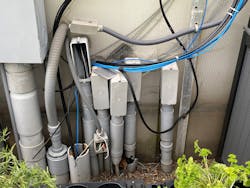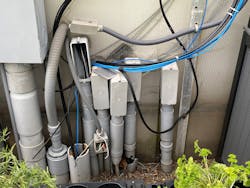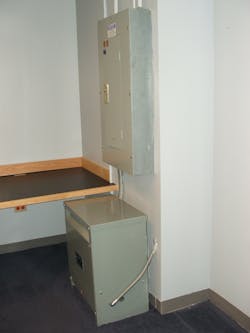All references are based on the 2023 edition of the NEC.
A Bundle of Bad Installations
There are several problems to discuss here. We can start with the missing covers from the junction box and PVC conduit body (i.e., LB). For completed installations, Sec. 314.15 requires each box to have a cover, faceplate, lampholder, or luminaire canopy. That same section in the Code requires conduit bodies, such as the LB, to be installed with a cover, lampholder, or device. Next, let’s focus on the broken rigid PVC conduits. For areas where rigid PVC conduit is exposed to physical damage, Schedule 80 PVC conduit should be installed as specified in Sec. 352.10(K). Installing expansion fittings where these conduits emerge from grade was a great idea and is now a requirement of Sec. 352.44(B), but even the expansion fittings could not prevent all types of damage to the conduits. Lastly, you can’t use liquidtight flexible nonmetallic conduit (LFNC) with PVC conduit fittings. Section 356.42 restricts fittings used with LFNC to only those fittings listed for use with LFNC. PVC conduit fittings are not listed for use with LFNC. Using fittings with the wrong wiring method is also a violation of Sec. 300.15 and Sec. 110.3(B).
Poor Choice of Transformer Placement
I’m not sure why the installer of this transformer and panelboard chose to put the transformer right in front of the panelboard instead of installing it in that space to the right. Whatever the reasons were, the present layout for this installation is a violation of the working space requirements of Sec. 110.26(A). While Sec. 110.26(A)(3) permits encroaching a maximum of 6 in. into the working space for this panelboard with electrical equipment associated with the panelboard, this transformer extends a little too far beyond the front of the panelboard and into the working space. Leaning against a grounded transformer enclosure while their hands are inside the enclosure of the energized panelboard significantly elevates the risk of shock for electrical workers. Another Code-compliant option could have been to install the transformer above the working space by hanging it from the structure using anchors with threaded rods and strut or similar hardware. I regularly see this method used in electrical rooms where space is at a premium. In a bit of irony, if you look closely at the cover of the panelboard enclosure, you may notice a label notifying persons to keep the space in front of the panel clear.
About the Author

Russ LeBlanc
Owner
Russ started in the electrical trade as an apprentice in 1985. He worked his way up to become a Journeyman Electrician and then eventually became a Master Electrician and Licensed Construction Supervisor. In 1999 Russ become an Electrical Instructor for The Peterson School of Engineering in Massachusetts where he developed his passion for teaching, and quickly became Department Head of Electrical Instruction. Russ has taught thousands of apprentices, electricians, engineers, inspectors, and other electrical professionals during his career as an instructor. He continues to provide electrical professionals with Electrical Code seminars, Arc-Flash Awareness training seminars and educational material through his LeBlanc Consulting Services in North Reading, MA whose specialty is educating electricians. He has been an active member of the NFPA Electrical Section and has authored hundreds of National Electrical Code proposals and comments which have become Code rules to improve the safety for the electrical industry. Russ is also an IAEI certified Electrical Inspector.
Please visit www.russleblanc.net for more information.


